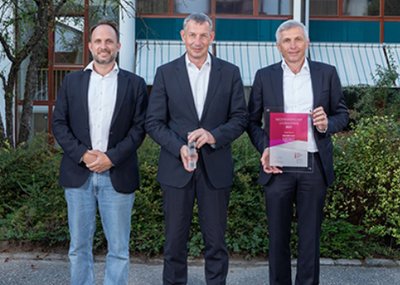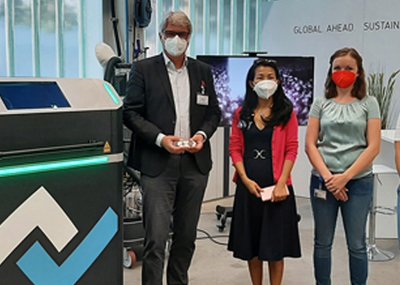Since each document may contain important information, they are processed and then archived. The accumulated documents are usually stored in file folders. Thus, it is not uncommon that the cabinets in the office or archive are overcrowded. If an employee needs a specific document, he or she must first go to the filing cabinet to find the right folder and the document he or she is looking for. This process naturally takes a lot of time. But even digitally stored data is not automatically better organized. Due to the distributed storage on hard disks, drives or in the e-mail inbox, the overview is quickly lost. One possibility to bring order back into the filing system is a document management system (DMS). A DMS software can, if used correctly, help to have a better overview of documents and to use and thus use time more effectively.
GLOBAL DATA VOLUME TO INCREASE TENFOLD TO 163 ZBYTE BY 2025
The mountains of data continue to grow steadily. This certainly also has to do with today's "we-save-everything" mentality. Every day, we generate and share countless data. IDC's 2017 whitepaper 'Data Age 2025' predicts that the amount of data worldwide will increase to 163 ZBbytes by 2025. To give you a better idea of this: One zettabyte is one billion terabytes. Many companies believe that this problem can be countered by moving to cloud-based storage. However, if handled incorrectly, the problem only shifts to a different place, as many employees then tend to be more careless with data and its storage.
30 percent of working time is spent searching
Searching for the right documents takes up a large part of daily work. The increased administrative and personnel effort naturally results in high costs. So that you as an decisions promptly, quick and easy access to relevant information is particularly important. The question of data storage is therefore becoming more and more important. With the help of a DMS software, a document is quickly and easily available, without that you have to search for it. But what is it exactly?
HOW DOES A DMS SOFTWARE WORK?
A DMS software is a database-driven system for managing and archiving documents of all kinds. First, all paper-based documents, such as billing documents, are scanned and thus digitized. The software uses metadata on the one hand and the so-called user or primary data on the other, which is the actual document. Metadata includes all the information that accompanies a document. This includes, for example, information about the author, the type of document, the customer number, the creation date, or even the person responsible. Based on the metadata, a document can be identified and managed without any doubt. The metadata of the files are stored in a database and must normally be entered by the user in the appropriate masks when setting up a document. entered by the user in the appropriate masks.
The document you are looking for can be easily found by entering a search term or even an invoice number in a text field. Searching for a document therefore takes only a few seconds. All incoming documents are stored in a central archive and are filed only once. This prevents multiple versions from being stored in different locations. To organize the documents in the way you are used to, the familiar folder structure is retained. Depending on the access rights, several people can view and edit a document. Older versions are not overwritten, so if a problem occurs, you can always revert to the previous version.
DMS can do more than just archive
The use of a DMS software has many advantages on different levels. Because it is not of data, but also to manage, store and organize the documents for the user in such a way that they are and organize them for the user in such a way that they can be retrieved quickly and easily. Evaluations, reports, time records, notifications - important documents are archived securely and transparently in the software. In addition, workflows are more efficient and communication within the company improves. Properly planned and implemented, the software noticeably improves work processes, increases quality and reduces costs.
The most important advantages at a glance:
- Central, secure and clear storage of documents
- Simple entry and operation
- High time savings: processing time and searching for a document are significantly reduced
- Reduced costs for storage space and paper
- Access to documents across locations, available at any time
- Optimization of collaboration within the company
- Increase in productivity
- Processes become traceable and transparent
- Risk of data loss decreases through reliable archiving
- Audit-proof and GoBD-compliant storage
ERP AND DMS - A COUPLING THAT BRINGS MANY ADVANTAGES
The coupling of a DMS software with the ERP system brings some advantages. The DMS software can capture and check both electronic and paper documents received. This makes it the perfect data provider for ERP systems. Documents you create in an ERP system can be automatically archived in the DMS software and merged with other documents. This process is referred to as electronic files. These files then contain all the information relating to a customer, for example. All information stored in the file is automatically indexed and provided with metadata. This makes it very easy to search for a specific document.
Data protection
When you archive a document in the DMS software, you can set access restrictions. You can decide for which persons or groups and on which level access is allowed or not. Furthermore, it is possible to grant editing and reading rights. If you pass on a document as a link, you can also determine whether it is only available for viewing or can also be downloaded.
Audit-proof storage
The tax authorities place high demands on a document archive. In Germany, every company must store its documents for up to 10 years and in some cases longer. To this end, the legislator has established a number of rules and requirements. The principles for audit-proof archiving are regulated in the GoBD (principles for the proper keeping and storage of books, records and documents). The GoBD largely refers to the storage of tax-relevant documents in electronic form, i.e. also an electronic archive or the storage as digital documents in a DMS software. According to the GoBD, documents must be stored in an audit-proof manner. Audit-proof basically means that documents are "unchangeable". All documents and records that are archived after processing may not be changed from that point on. In addition, you should note that electronically created documents must also be digitally archived. If you would like to learn more about DMS software or the entire range of functions of TimeLine ERP, please feel free to visit us at GIFA at our booth D10 in hall 13 or contact our sales team at +49 212 230 35 200! We look forward to meeting you and advising you.
About the TimeLine Business Solutions Group
With 30 years of experience in the ERP market and a continuous development of ERP systems precisely oriented to customer needs, TimeLine Business Solutions Group has established itself as one of the most innovative and versatile providers in the ERP market. The ambition to offer customizable and future-proof ERP solutions with a range of functions and price-performance ratio tailored to the needs of medium-sized industrial companies still forms the basis for the orientation of the group of companies and the product portfolio today. TimeLine has already been awarded "ERP System of the Year" eight times, including in the category 'Best Technology`.
Today, the TimeLine Business Solutions Group, headquartered in Solingen, Germany, comprises a total of 15 companies and a number of partners with locations in Germany, Switzerland, the Netherlands, Poland, Bulgaria, Romania, Slovakia, Luxembourg and India. Around 180 employees support over 1,200 customers with more than 22,000 installations.






